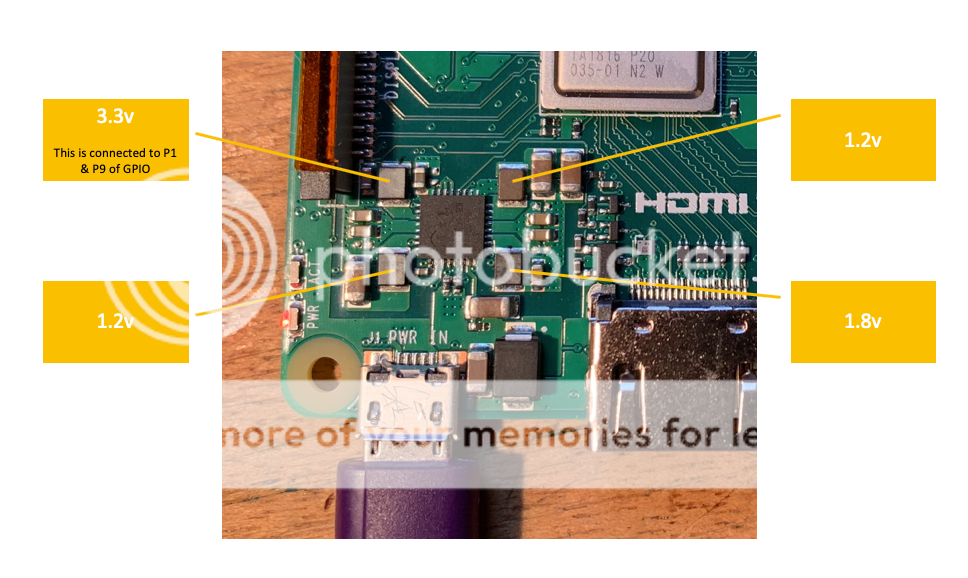OK, I think i have a plan!
Looking at the Pi 3B+ I do need to keep the 1.2v and the power is distributed around the Pi like this:

So, my plan is to remove the inductors for the 3.3 and the 1.8 then directly solder connection from the mezzanine 1.8v output to the 1.8v inductor pad (the one that isn't connected to the DC/DC chip).
Looking at the Pi 3B+ I do need to keep the 1.2v and the power is distributed around the Pi like this:

So, my plan is to remove the inductors for the 3.3 and the 1.8 then directly solder connection from the mezzanine 1.8v output to the 1.8v inductor pad (the one that isn't connected to the DC/DC chip).
Scrap the above idea. I tried removing the 3.3v inductor and it powered up but no boot. Replacing the inductor works fine either powering pi direct or via mezzanine. back to drawing board.,
This should explain why you won't be able to do anything about it: More power to your Pi - Raspberry Pi
Short version - the chip not only supplies the rails but measures the supplied voltage/current and is controlled by the RPi firmware, so when the firmware doesn't see the readings it expects from the chip it doesn't boot...
I guess you could modify the firmware and bypass the monitoring logic.
Short version - the chip not only supplies the rails but measures the supplied voltage/current and is controlled by the RPi firmware, so when the firmware doesn't see the readings it expects from the chip it doesn't boot...
I guess you could modify the firmware and bypass the monitoring logic.
Dang it. Thanks @wealas, that saved me some time. Hmmm, need to ponder this one and do a little more research!
Hi, pls make a 6xLT3045 or 8xLT3045 for 5V 3-4A linear psu. I want to fit to my Dac. Your product is high quality and inexpensive ! I like my mezzanine board.
Just parallel 4 of his twin lt3045 boards, it's easy. I use 2 pairs for my Brooklyn psu.
Yes, but I thinks 2 pairs must equal Voltage outputs. And if it made in a intergrated board better for us because wires shorter ànd less noise.
im also curious, so i dig this up again, is it possible to do this on the raspberry pi 4 or cm4 ?
as i understood things so far the pi4 and cm4 only needs 5v 3,3v and 1,8v again, the only thing that could be important is the "power sequencing" thing
as i understood things so far the pi4 and cm4 only needs 5v 3,3v and 1,8v again, the only thing that could be important is the "power sequencing" thing
Last edited:
(unfortuanly) i found the answer ... the raspberry pi 4 seems to use a "all in one" chip that offers the different voltage rails which also communicates with the kernel drivers over i2c, so its not easy to replace it
i wonder if placing carefully capacitors to the inductors (either before or after the inductor and the other end to ground) could atleast improve the voltage rails of the switching voltage regulators inside this chip, it will probably never reach linear regulator teretory but maybe it will get closer
i have to research this a little since im not too keen on circuit design but it should be possible to make a little "adapter board" with capacitors placed on it and hooking wires to either end of the inductor and finding a good grounding point (any help would be much appreciated 🙂 )
i wonder if placing carefully capacitors to the inductors (either before or after the inductor and the other end to ground) could atleast improve the voltage rails of the switching voltage regulators inside this chip, it will probably never reach linear regulator teretory but maybe it will get closer
i have to research this a little since im not too keen on circuit design but it should be possible to make a little "adapter board" with capacitors placed on it and hooking wires to either end of the inductor and finding a good grounding point (any help would be much appreciated 🙂 )
- Home
- Source & Line
- PC Based
- Mezzanine Power board for Raspberry Pi